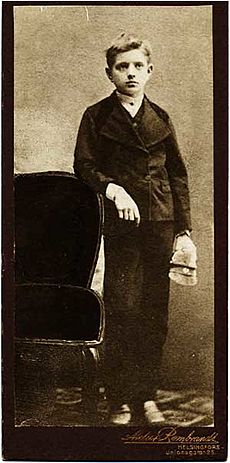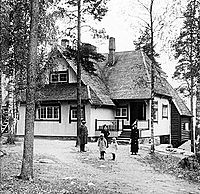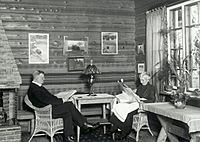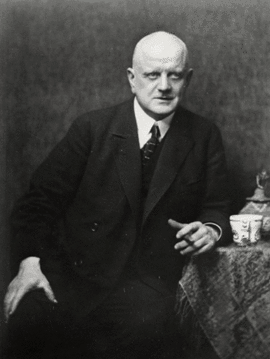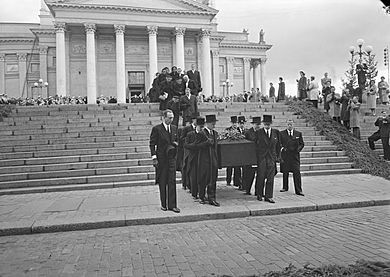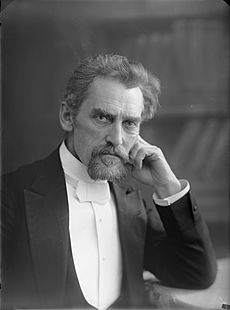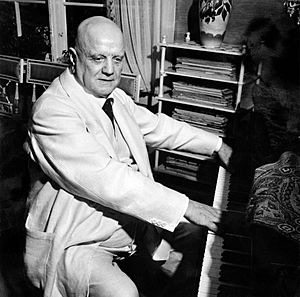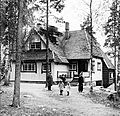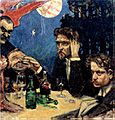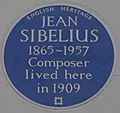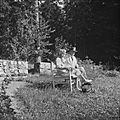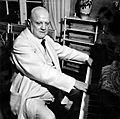Jean Sibelius facts for kids
Quick facts for kids
Jean Sibelius
|
|
|---|---|
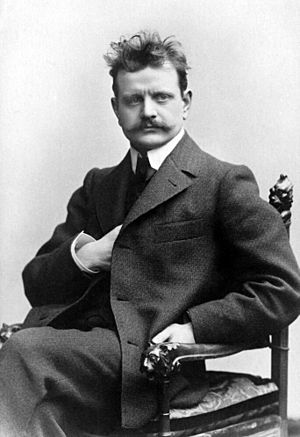 |
|
| Born | 8 December 1865 |
| Died | 20 September 1957 (aged 91) Järvenpää, Finland
|
|
Works
|
List of compositions |
| Signature | |
 |
|
Jean Sibelius (born Johan Julius Christian Sibelius; 8 December 1865 – 20 September 1957) was a famous Finnish composer. He lived during the late Romantic and early-modern music periods. Many people consider him Finland's greatest composer. His music helped Finland develop its own national identity when it was trying to become independent from Russia.
Sibelius is best known for his seven symphonies. These, along with his other major works, are often played and recorded around the world. Other famous pieces include Finlandia, the Karelia Suite, Valse triste, and his Violin Concerto. He also wrote music inspired by nature, Nordic myths, and the Finnish epic poem, the Kalevala. He composed over a hundred songs, music for plays, an opera, and pieces for chamber music and piano.
Sibelius wrote a lot of music until the mid-1920s. After finishing his Seventh Symphony in 1924 and the tone poem Tapiola in 1926, he stopped creating major works. This period is often called the "silence of Järvenpää", where he lived. Even though he didn't publish much new music, he did try to write an eighth symphony. He also revised some older works.
His picture was on the Finnish 100 mark note until 2002. Since 2011, Finland celebrates a special flag day on December 8th, his birthday. It's known as the Day of Finnish Music. In 2015, many concerts and events were held in Helsinki to celebrate 150 years since his birth.
Contents
Life of Jean Sibelius
Early Years and Family
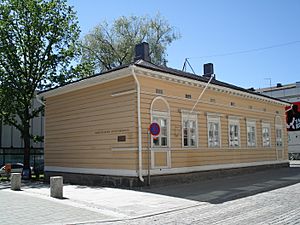
Jean Sibelius was born on December 8, 1865, in Hämeenlinna, Finland. At that time, Finland was a part of the Russian Empire. His father, Christian Gustaf Sibelius, was a doctor. His mother was Maria Charlotta Sibelius. The family spoke Swedish.
Sibelius's father died when Jean was only two years old. His mother, who was pregnant, had to sell their home. They moved in with his grandmother. Sibelius grew up mostly surrounded by women. His uncle, Pehr Ferdinand Sibelius, was a big influence. He loved music, especially the violin. Uncle Pehr gave Jean a violin when he was ten. He also encouraged Jean to compose music.
From a young age, Sibelius loved nature. He often walked in the countryside during summer. He said, "For me, Loviisa represented sun and happiness. Hämeenlinna was where I went to school; Loviisa was freedom." He started piano lessons at seven. He later preferred the violin. He played in trios with his older sister Linda on piano and younger brother Christian on cello. Christian later became a famous psychiatrist.
Sibelius started violin lessons in 1881. He dreamed of becoming a great violin player. He became quite good, performing concerts in 1886 and 1887. But in the end, he chose to become a composer.
Even though his first language was Swedish, he went to a Finnish-speaking school from 1874. He did well in math and botany. He passed his final exams in 1885, which allowed him to go to university. As a boy, he was called Janne. But as a student, he started using the French name Jean. This was inspired by his uncle's business card.
Studies and Early Music Career
After high school in 1885, Sibelius began studying law at the University of Helsinki. But he was much more interested in music. He soon moved to the Helsinki Music Institute, where he studied from 1885 to 1889.
One of his teachers was Martin Wegelius, who taught him formal composition. Another important teacher was Ferruccio Busoni, a pianist and composer. Sibelius became lifelong friends with him. He also met Armas Järnefelt, who introduced him to his sister Aino. Aino would later become Sibelius's wife.
Sibelius continued his studies in Berlin (1889–1890) and Vienna (1890–1891). In Berlin, he heard many concerts and operas. He also heard the Finnish composer Robert Kajanus conduct a patriotic piece. This might have made Sibelius interested in using the Kalevala for his own music. In Vienna, he became very interested in the music of Anton Bruckner. He also enjoyed the works of Beethoven and Wagner.
In Vienna, he started writing for orchestras. He began working on Kullervo, a large orchestral work inspired by the Kalevala. He got sick but recovered after surgery. When he returned to Helsinki, he successfully conducted some of his new pieces. Kullervo premiered in Helsinki in April 1892 and was a huge success. This showed his growing interest in Finnish culture.
Sibelius also traveled to Italy in 1900 with his family. He composed, conducted, and met people in many European countries and later in the United States.
Marriage and Growing Fame
While studying in Helsinki in 1888, Sibelius met Aino Järnefelt. She was 17 and the daughter of a general. They fell in love and married on June 10, 1892. They spent their honeymoon in Karelia, a region that inspired many of Sibelius's works.
Their home, Ainola, was finished in 1903 near Lake Tuusula. They had six daughters: Eva, Ruth, Kirsti (who died young), Katarina, Margareta, and Heidi.
In 1892, Kullervo marked Sibelius's focus on orchestral music. People called it a "volcanic eruption" and "Finnish music." In 1893, his piece En saga was first played. Later that year, the full version of Karelia premiered. Sibelius's music was played more and more in Helsinki.
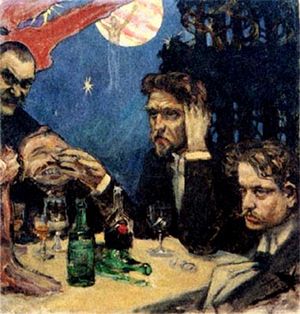
Sibelius worked on an opera based on the Kalevala, but he never finished it. Instead, he used some of the music for his Lemminkäinen Suite. This suite was first played in 1896.
To earn money, Sibelius taught music from 1892. This left him little time to compose. But in 1898, he received a large yearly grant. This allowed him to focus on composing. He wrote music for the play King Christian II, which was very popular.
In January 1899, Sibelius started his First Symphony. At this time, Russia was trying to limit Finland's power. The symphony was well received. He also wrote the patriotic Song of the Athenians, which made him a national hero. Another patriotic work, Press Celebration Music, followed. Its last part, Finland Awakens, became the famous Finlandia.
In 1900, Sibelius's youngest daughter died. Despite this, he went on an international tour with Kajanus and his orchestra. They played his new works in many European cities. Critics praised his music, bringing him international fame.
In 1901, Sibelius began his Second Symphony in Italy. It was completed in 1902 and premiered in Helsinki. Finns loved it, seeing it as a masterpiece. It further cemented his reputation as a national hero during Russian rule.
In 1903, Sibelius spent much time in Helsinki. He composed Valse triste, a short orchestral piece. It was part of the music for his brother-in-law's play. He sold the piece for a low price, but it became very popular worldwide. His wife, Aino, often wrote to him, asking him to come home. In 1904, he finished his Violin Concerto. Its first performance was not successful. He revised it, and the new version was a great success in Berlin the next year.
Life at Ainola
In 1903, Sibelius started building his new home, Ainola (Aino's Place). It was near Lake Tuusula, north of Helsinki. To pay for it, he gave concerts. The family moved in on September 24, 1904. They became friends with other artists living nearby.
In 1905, Sibelius conducted his Second Symphony in Berlin. He also visited Britain for the first time. He conducted his First Symphony and Finlandia in Liverpool. He wrote to Aino that the concert was a great success.
In 1906, Sibelius composed Pohjola's Daughter, another piece based on the Kalevala. He also wrote music for Belshazzar's Feast. He ended the year by conducting Pohjola's Daughter in St. Petersburg.
Health Challenges and New Music
In 1907, Sibelius's lifestyle affected Aino's health. She had to go to a sanatorium. While she was away, Sibelius decided to change his habits. He focused on composing his Third Symphony. He finished it for a performance in Helsinki in September. Its more classical style surprised the audience.
Sibelius met Gustav Mahler in Helsinki. They both felt that with each new symphony, they might lose some fans of their earlier works. This was true for Sibelius's Third Symphony in St. Petersburg, where it received negative reviews.

In 1907, Sibelius had a serious throat operation. In 1908, his health worsened. He had another operation to remove a tumor from his throat. This experience with serious illness is believed to have inspired works like Luonnotar and his Fourth Symphony.
Happier Times and More Compositions
After his successful throat operation in 1909, Sibelius and Aino were happier. His music was also well received in Britain. He met Claude Debussy, another famous composer.
Sibelius began his Fourth Symphony in 1910. He also wrote smaller pieces to earn money. He conducted concerts in Oslo, where his Valse triste and Second Symphony were very popular.
In 1911, his Third Symphony was well received in Sweden. He finished his Fourth Symphony in April. Its quiet, thoughtful style was not as warmly welcomed in Helsinki at first. In 1912, he completed Scènes historiques II. It was performed with the Fourth Symphony to enthusiastic audiences.
In 1913, Sibelius composed the tone poem The Bard. He also wrote Luonnotar (Daughter of Nature) for a singer and orchestra. It was based on the Kalevala. In 1914, he composed The Oceanides for a music festival in America. It was praised as beautiful sea music. While in America, he received honorary degrees from Yale University and the University of Helsinki.
First World War Years
While returning from the United States, Sibelius heard about the start of World War I. His income from abroad stopped. To make money, he wrote smaller pieces for Finland. In March 1915, his work The Oceanides was well liked in Sweden.
While working on his Fifth Symphony in April, he saw 16 swans flying. This inspired the symphony's ending. He completed the symphony by his 50th birthday on December 8.
Sibelius conducted the premiere of his Fifth Symphony in Helsinki. He was not fully satisfied with it and soon began to revise it. He was also in debt. Friends helped him by raising money to pay off his debts.
A year later, in December 1916, Sibelius presented a revised version of his Fifth Symphony. He continued to revise it again.
By late 1917, Sibelius composed his Jäger March. This piece became very popular after Finland declared independence from Russia. The Jäger March was first played in January 1918. Soon after, the Finnish Civil War began. Sibelius supported the White Guards. His wife, Aino, had some sympathy for the Red Guard.
During the war, his home was searched. His brother, Christian, was arrested. Sibelius's friends helped him and his family move safely to Helsinki. After the war ended, Sibelius conducted the Jäger March at a concert celebrating the German troops.
Later Years and Final Works
In 1919, Sibelius changed his look by shaving his thinning hair. He visited Copenhagen and successfully presented his Second Symphony. In November, he conducted the final version of his Fifth Symphony, receiving many cheers. He then started working on his Sixth Symphony.
In 1920, Sibelius composed the Hymn of the Earth. He also received a large donation from Finnish businesses. He used some of it to pay debts.
Sibelius had a very successful trip to England in 1921. He conducted several concerts, including his Fourth and Fifth symphonies. He also conducted in Norway. He was getting tired, but critics remained positive.
In 1922, Sibelius was saddened by the death of his brother Christian. He also joined the Finnish Freemasons and composed music for their rituals. In February 1923, he premiered his Sixth Symphony. It was praised as "pure idyll." He also conducted concerts in Stockholm and Rome.
Despite some health issues, Sibelius completed his Seventh Symphony in early 1924. It was first performed in Stockholm and was a success. He received an honor for his work.
He spent most of the rest of the year resting. In May 1925, he was asked to compose music for Shakespeare's play The Tempest. He finished it before its premiere in March 1926.
Sibelius had a tremor in his hands, which may have affected his ability to write music and socialize.
Last Major Contributions
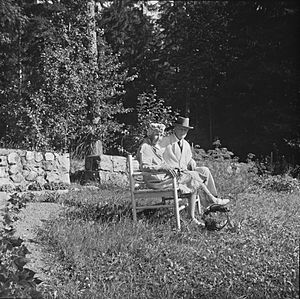
After 1926, Sibelius wrote very few major works. His most important pieces from this time were the music for The Tempest and the tone poem Tapiola. For the last 30 years of his life, he rarely spoke publicly about his music.
There is evidence that Sibelius worked on an eighth symphony. He even promised its premiere. But no complete manuscript exists. Sibelius was very self-critical. He once said, "If I cannot write a better symphony than my Seventh, then it shall be my last." It is believed he destroyed most of the score, possibly in 1945.
Second World War Years
On his 70th birthday in 1935, Sibelius received the Goethe-Medal from the German Nazi regime. After the Winter War (1939–1940) between Finland and the Soviet Union, the Sibelius family returned to Ainola in 1941.
In 1939, Sibelius conducted his Andante Festivo in an international radio broadcast. This is probably the only recording of Sibelius conducting his own music.
Final Years and Death
From 1903, Sibelius lived mostly in the countryside. After 1941, he rarely visited Helsinki. The "silence of Järvenpää" became a legend. But he still had many visitors, including his grandchildren.
Sibelius did not often speak about other composers. But in private, he admired Richard Strauss and thought Béla Bartók and Dmitri Shostakovich were very talented. In the 1950s, he supported the young Finnish composer Einojuhani Rautavaara.
His 90th birthday in 1955 was widely celebrated. Orchestras in Philadelphia and London performed his music.
Two years later, on September 20, 1957, Sibelius died at Ainola from a brain haemorrhage. He was 91 years old. At the time of his death, his Fifth Symphony was being broadcast on the radio. The President of the United Nations General Assembly called for a moment of silence. He said, "Sibelius belonged to the whole world. He enriched the life of the entire human race with his music." Sibelius received a state funeral and is buried in the garden at Ainola.
Aino Sibelius lived at Ainola for 12 more years. She died in 1969 at 97 and is buried next to her husband.
Music of Jean Sibelius
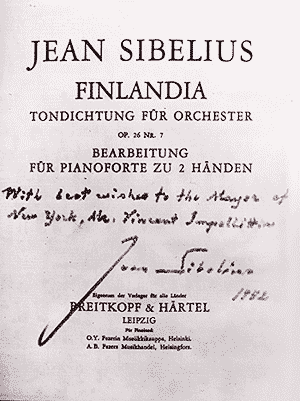
Sibelius is widely known for his symphonies and tone poems. These include Finlandia and the Karelia Suite. His fame in Finland grew in the 1890s with Kullervo. Like many of his works, it was inspired by the Kalevala. His First Symphony was first played in 1899, when Finnish nationalism was strong.
Besides his seven symphonies, he became popular with music for plays and more tone poems. These include En saga, The Swan of Tuonela, and Valse triste. Sibelius also wrote a Violin Concerto, an opera called Jungfrun i tornet, and many shorter orchestral pieces. He also composed chamber music, piano and violin works, choral pieces, and many songs.
In the mid-1920s, after his Sixth and Seventh Symphonies, he composed the symphonic poem Tapiola. He also wrote music for The Tempest. After that, he did not publish any more major works, even though he lived until 1957. For several years, he worked on an Eighth Symphony, but he later burned it.
His early music, like his First Symphony and Violin Concerto, shows hints of Tchaikovsky. He was also influenced by Ferruccio Busoni and Anton Bruckner. For his tone poems, he was mainly inspired by Liszt. Similarities to Bruckner can be heard in the brass parts of his orchestral works.
Sibelius gradually moved away from traditional sonata form in his music. Instead of using many contrasting themes, he focused on developing small musical ideas. These ideas would grow and change into a grand statement. His later works show a continuous development of themes. This makes his music feel complete and natural.
This unique style was different from Gustav Mahler's symphonies. While both composers used theme variations, Mahler's music had sudden, contrasting themes. Sibelius, however, slowly transformed his musical ideas.
Sibelius's Symphonies
Sibelius began his Symphony No. 1 in 1898 and finished it in early 1899. He was 33 years old. It was first played in Helsinki in April 1899. Sibelius revised it, and the version we hear today was first played in Berlin in 1900. The symphony starts with a lonely clarinet solo.
His Second Symphony is his most popular. It was first played in Helsinki in March 1902. The opening chords set a theme for the whole piece. Its heroic ending made Sibelius a national hero during Russian rule. Sibelius made some changes after the first performance.
The Third Symphony is a cheerful and simple-sounding piece. It was first played in Helsinki in September 1907. It has themes from Finnish folk music. This symphony is different from his first two. It has a clear style that leads to a marching sound at the end.
His Fourth Symphony premiered in Helsinki in April 1911. He wrote it while having throat operations. The beginning, with cellos and bassoons, shows a new way of using rhythm. It then becomes sad, based on a poem. The quiet ending might hint at the "silence" Sibelius would experience later in life.
Symphony No. 5 premiered in Helsinki on his 50th birthday in December 1915. The version played today was revised in 1919. It is Sibelius's only symphony entirely in a major key. It starts softly with horns and builds up to a powerful "swan hymn" at the end.
The Sixth Symphony was first played in February 1923. It is even further from traditional symphony forms. It uses lighter instruments like flutes and strings, instead of the heavy brass of the Fifth.
Symphony No. 7 in C major was his last published symphony. Completed in 1924, it has only one movement. It is known for its original form and how it handles musical speed and keys. It has been called Sibelius's most remarkable work. It was first played in Stockholm in March 1924.
Sibelius's Tone Poems
After his symphonies and violin concerto, Sibelius's thirteen symphonic poems are his most important orchestral works. They are among the most important pieces in this style since Franz Liszt. These poems were written throughout Sibelius's career, from 1892 to 1925. They show his love for nature and Finnish mythology, especially the Kalevala.
En saga (meaning "A Fairy Tale") was first played in February 1893. Sibelius said it was "an expression of [his] state of mind." It starts with a dreamy string theme and shows Sibelius's skill with an orchestra. He revised it in 1902, which helped establish his reputation in Germany.
The Wood Nymph was written in 1894. It was inspired by a Swedish poem. It has four sections, each matching a part of the poem. It shows heroic energy, frantic activity, love, and sadness.
The Lemminkäinen Suite was composed in the early 1890s. It was originally planned as an opera. It became an orchestral piece with four movements. It is based on the character Lemminkäinen from the Kalevala. The section The Swan of Tuonela is often played by itself.
Finlandia is probably Sibelius's most famous work. It is a very patriotic piece. It was first played in November 1899. It became popular worldwide, even with choirs. Sibelius later agreed to add words to the hymn part.
The Oceanides is a tone poem written in 1913–1914. It refers to the nymphs in Greek mythology who lived in the sea. It premiered in Connecticut in 1914. It was praised as "the finest evocation of the sea ever produced in music." It shows a calm ocean, a gathering storm, and a thunderous wave.
Tapiola, Sibelius's last major orchestral work, was first played in New York in 1926. It is inspired by Tapio, a forest spirit from the Kalevala. One critic called it Sibelius's "most severe and concentrated musical statement."
Other Important Works
The Karelia Music was one of Sibelius's earlier works. It was first played in November 1893. The Karelia Suite came from this music. It is still one of Sibelius's most popular pieces.
Valse triste is a short orchestral piece. It was originally part of the music for a play called Kuolema (Death). It is now much more famous as a separate concert piece. It became an instant success and is one of Sibelius's signature works.
The Violin Concerto in D minor was first played in February 1904. The soloist did not have enough time to prepare, so the performance was not good. After many changes, a new version was played in Berlin in 1905 and was a huge success. This piece has become very popular. It is the most recorded violin concerto from the 20th century.
Kullervo is an early work by Sibelius. It is sometimes called a choral symphony. It is based on the character Kullervo from the Kalevala. It was first played in April 1892. Although it was not played often during Sibelius's life, it has become very popular since the 1990s.
Activities and Interests
Freemasonry
When Freemasonry in Finland was allowed again, Sibelius became one of the first members of a lodge in 1922. He later became the Grand Organist for the Grand Lodge of Finland. He composed the special music used in their rituals.
Nature
Sibelius loved nature very much. The Finnish landscape often inspired his music. He once said his Sixth Symphony reminded him of "the scent of the first snow." The forests around his home, Ainola, are said to have inspired his piece Tapiola.
Legacy of Jean Sibelius

In 1972, Sibelius's daughters sold Ainola to the Finnish state. It opened as a museum in 1974. Sibelius has been honored in many ways. His image was on the Finnish 100 mark bill until 2002. Since 2011, December 8th, his birthday, is a flag day in Finland. It is also known as the "Day of Finnish Music." In 2015, many special concerts and events were held in Helsinki to celebrate 150 years since his birth.
Many things are named after him. These include the International Jean Sibelius Violin Competition, the Sibelius Monument in Helsinki, the Sibelius Museum in Turku, and the Sibelius Hall concert hall in Lahti. Even an asteroid, 1405 Sibelius, is named in his honor.
A complete collection of all Sibelius's works has been prepared in Finland since 1996. It will have 60 volumes.
Sibelius kept a diary from 1909 to 1944. His family allowed it to be published in 2005. It was also published in Finnish in 2015 for his 150th anniversary. Many of his letters have also been published.
The popular music writing program, Sibelius, is named after him.
Images for kids
-
Sibelius's birthplace in Hämeenlinna
-
Sibelius (right) socializing with Akseli Gallen-Kallela (the artist, left), Oskar Merikanto, and Robert Kajanus
-
Blue plaque, 15 Gloucester Walk, Kensington, London, his home in 1909
-
Sibelius and Aino in Järvenpää (early 1940s)
-
Jean Sibelius' Finlandia premiere edition; 1952 autographed copy for the Mayor of New York City, Vincent Impellitteri
-
The Sibelius Park (Sibeliuksenpuisto) in Kotka, Finland
See also
 In Spanish: Jean Sibelius para niños
In Spanish: Jean Sibelius para niños


